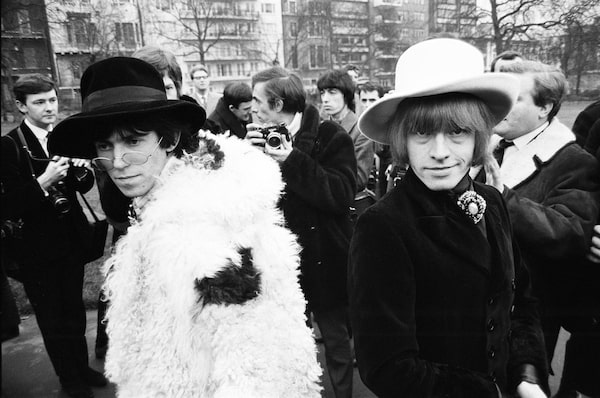In June, 1969, a deteriorating and disillusioned Brian Jones was kicked out of the Rolling Stones, the band he co-founded and once led. Weeks later, on July 3, 1969, he drowned in his swimming pool at Cotchford Farm, the former Sussex home of Winnie-the-Pooh writer A. A. Milne. Jones was only 27 – the first of the so-called 27 Club of prominent musicians who died at that young age. Compared to Jimi Hendrix, Janis Joplin, Jim Morrison, Kurt Cobain and Amy Winehouse, Jones is the least-known member.

Rolling Stones co-founder Brian Jones, who dies in 1969 just weeks after being kicked out of the band, is the subject of the new documentary The Stones and Brian Jones.Peter Stone/Mongrel Media
Now, with Nick Broomfield’s revealing new documentary The Stones and Brian Jones, the dead guitarist receives second billing in a film about him.
“He was his own worst enemy,” says the 75-year-old Broomfield, on a video conference call from his home south of London. “He treated people badly. He made it impossible for the band to carry on with him.”
The Stones still carry on. Last month the band, with original members Mick Jagger and Keith Richards, released its latest album, Hackney Diamonds.
The film hits theatres on Friday. It opens big with a quote from Stones biographer Stanley Booth: “Brian Jones was a casualty of the war between two generations.” Out of the post-war conservatism of the 1950s, a counterculture was born – free-loving flower children vs. their parents; hippies against squares. Of sex, drugs and rock ‘n’ roll, the music eventually came in third for Jones.
Shortly after Jones’s death, the Stones gave a performance in tribute to him in London’s Hyde Park. Of the some 500,000 attendees, Broomfield was one. For him, the concert and Jones’s demise marked the end of Sixties.

The documentary's writer and director Nick Broomfield was among the some 500,000 attendees at a Rolling Stones performance in in London’s Hyde Park held shortly after Jones’s death.Peter Stone/Mongrel Media
“People had been free and had done things in a fairly reckless manner, and they got away with it until Brian’s death,” says the veteran documentarian. “It was a big moment, when everybody had to pause and look at what happened. Maybe doing what you want wasn’t going to work – the experiment kind of ended there.”
That thinking is his film’s intellectual thrust. But the quiet soul of the documentary is the sympathetic portrait of Jones as a son emotionally abandoned by his disapproving parents, a musician kicked to the curb by the Stones and a self-loathing man dropped by his glamourous girlfriend, Anita Pallenberg.
His parents, in a move that would fall under the heading of “tough love” today, packed his suitcase and placed it in the driveway when Jones was 17. Later, when their son became famous as a Rolling Stone, they ignored his concert invitations.
“They never endorsed him being a musician,” says Broomfield, also the film’s narrator. “He always tried to get their attention, and the less approval he got, the more extreme his behaviour became.”
Adrift from his own parents, he found surrogates in the families of a string of younger girlfriends. He charmed the parents with his soft-spoken civility and gallant manner. Dawn Molloy, Jones’s girlfriend in 1964, speaks in the film about the pop-star guitarist meeting her mother for the first time: “He kissed her hand. Who does that?”
Jones’s modus operandi of winning over parents and seducing their daughters, only to leave the girls after impregnating them, was pathological. Yet the former girlfriends interviewed for the documentary uniformly feel sorry for Jones. “I think he was a lost person,” said Molloy.

Brian Jones and Keith Richards of The Rolling Stones in Green Park London in January, 1967 prior to their departure to the U.S. where they were to appear on the Ed Sullivan coast-to-coast show.Peter Stone/Mongrel Media
Bloomfield spoke to former Stones bassist Bill Wyman for the film, but not to Richards and Jagger. He says those two musicians have a reputation for being too controlling when it comes to Stones-related projects, and that he’d rather make the film “without having to run the gauntlet.”
(Archival footage and interviews of Richards and Jagger are used.)
What is missing from the documentary is the speculation that Jones did not die by accidental drowning but by manslaughter (or possibly even murder), as suggested by Danny Garcia’s 2020 documentary Rolling Stone: Life and Death of Brian Jones and A. E. Hotchner’s 1990 book Blown Away: The Rolling Stones and the Death of the Sixties.
It is an unexpected omission from Broomfield, whose Kurt & Courtney documentary from 1998 controversially investigated the circumstances surrounding the death – officially ruled a suicide – of Nirvana’s grunge rock icon Cobain.
But the director, who as a teenager met Jones on a train – “he was incredibly polite” – flatly rejects any conspiracy theory surrounding his death. “It’s woolly and inaccurate.”
One theory put forward in the film is not conspiracy, but tragedy. The late music biographer David Dalton suggested that by expelling Jones from the band, the other Stones had so much as killed him.
“A rock group is sort of like a primitive tribe,” explained Dalton, who died last year at 80. “People are often killed by tribes psychically if they’re expelled, and a rock group is sort of like that. Their whole lifeblood comes from that bond. Once they’re of no use, that is often fatal … they just go off into the woods and die.”
 Brad Wheeler
Brad Wheeler